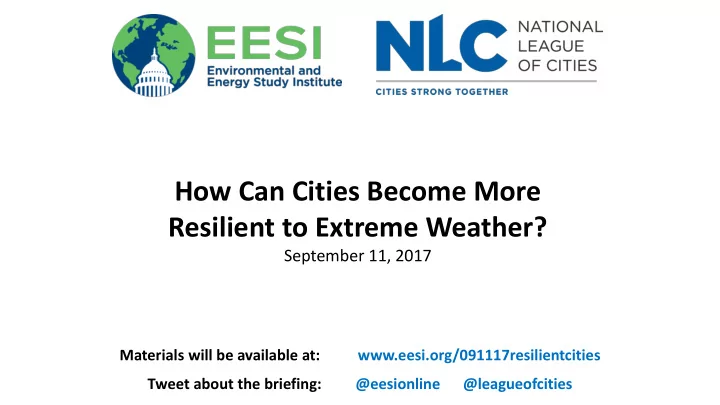

How Can Cities Become More Resilient to Extreme Weather? September 11, 2017 Materials will be available at: www.eesi.org/091117resilientcities Tweet about the briefing: @eesionline @leagueofcities
• Founded in 1984 by a bipartisan Visit www.eesi.org to: Congressional caucus. • Subscribe to our weekly newsletters, Climate • Now an independent , bipartisan Change News and nonprofit with no Congressional funding. Sustainable Bioenergy, Farms, and Forests . • We provide fact-based information on • View videos of our energy and environmental policy for Congressional briefings. Congress and other policymakers. • Sign up to receive our • We focus on win-win solutions to make briefing notices and fact sheets . our energy, buildings, and transportation sectors sustainable .
Resiliency in Flagstaff, Arizona: A Community Commitment Nicole Antonopoulos Woodman, City of Flagstaff 4
Flagstaff, Arizona Founded in 1882 Population 67,500 Elevation 7,000 ft / 2,130 m Largest contiguous Ponderosa Pine forest in the world Tourism, education, and government based economy
How do we reduce our vulnerability to and Climate Projections prepare for the changing climate? Rising temperatures Intensified storms Reduced snowpack Drier forests More severe and frequent forest fires Increased risk of extreme flooding
Flagstaff Climatic Extremes - 2010 Cold Snow Wind Drought Tornados Heat Forest fires Floods
Resiliency and Preparedness WHAT WE ASKED OURSELVES WHAT WE ASSESSED 1. How vulnerable are our operations, 1. Our level of vulnerability to local infrastructure, and economy to climate variability climate related disasters? 2. The degree of risk to local climate 2. Where does the City lack sufficient variability capacity to adapt to climate 3. What are the potential impacts to local variability? climate variability 3. What are the risks if we do not act? 4. What do we need in order to reduce vulnerability and risk
We must take a systems approach in preparing for the changing climate.
Volatility of Change Must design and redesign systems to better absorb disruption Must operate under a wider variety of conditions Must be able to shift more fluidly from one circumstance to the next
Flagstaff Watershed Protection Project
Schultz Fire a Reality Continual flooding damage despite fire containment success High-severity burn impacted the hydrologic behavior of the landscape Widespread flooding, large flood and debris flows – impacting areas four miles from the burn area High fire risk on steep slopes near downtown Flagstaff Catastrophic flooding risk throughout town Risks to 50% of municipal water source 12
FWPP 2012 $10M bond initiative (74% approval) 1st payment for Ecosystem Services project to result from a citizen vote Multi-agency partnership: USFS State of Arizona Navajo Nation City of Flagstaff Northern Arizona University Four Forest Restoration Initiative Greater Flagstaff Forest Partnership 13
FWPP 2012: Planning 2013-2015: NEPA process Today: Thinning in forests Future: Steepest slopes Future: Identify sustained funding mechanism 14
What made it work? Enhanced public awareness of fire and water nexus Prior education on forest health and fire threat Alignment with concurrent projects Investing in community assets Focus on cost avoidance Community identity with forest
Climate Action and Adaptation Plan
Climate Action and Adaptation Plan 1. Set a goal to reduce community greenhouse gas (GHG) emissions 2. Outline the specific steps that the Flagstaff community will take to reduce GHG emissions ( mitigation ) 3. Outline actions to prepare for climate changes ( adaptation )
Climate Action and Adaptation Plan ELEMENTS – WHAT WE WANT TO SEE GOALS – HOW WE’LL GET THERE Climate impacts and projections Obtain broad community input and ownership Vulnerability assessment Address vulnerable populations and recognize Strategies Flagstaff’s history, diversity, unique strengths, and challenges Mitigation and adaptation strategies Scenario development Hold asset-based conversations Emissions forecast Use multiple channels of outreach Action and implementation plan Return on investment analysis Community Action Toolkit
GHG municipal and community tracking Renewable energy installations Resiliency and Preparedness: Municipal and community wide education Existing Efforts Municipal projects Asphalt engineering Flagstaff airport Water services Regional partnerships Western Adaptation Alliance Residential energy efficiency Rebates Do-it-yourself training and supplies
Thank you Nicole Antonopoulos Woodman nwoodman@flagstaffaz.gov 928.213.2149
How Can Cities Become More Resilient to Extreme Weather? Cooper Martin, Program Director, Sustainable Cities Institute
Leadership in Community Resilience Goals • Collect and share ideas and best practices that will help advance local resilience efforts • Develop and test models for NLC to engage with elected officials, staff, and community groups in member cities on resilience issues • Provide direct support to enhance or expand the existing resilience priorities of 10 local communities
Resilience vs. Sustainability for Cities • Sustainability = limit the negative impacts that human activity will have on the environment • Resilience = limit the negative impacts that the environment will have on human activity
Leadership in Community Resilience
Annapolis, MD
San Antonio, TX
NLC Recommendations 1. Preparedness – National Flood Insurance Program should be reauthorized, affordable, and solvent 2. Mitigation – cities and property owners should be encouraged to retrofit existing structures 3. Relief - Continued disaster emergency assistance provided to states and communities in the path of Harvey, Irma, Western wildfires, and flooding events nationwide 4. Recovery - Rebuilding should consider future climate risk and vulnerabilities
Thank You! Cooper Martin Sustainable Cities Institute cmartin@nlc.org @SustCitiesInst
How Can Cities Become More Resilient to Extreme Weather? What did you think of the briefing? Please take 2 minutes to let us know at: www.eesi.org/survey Materials will be available at: www.eesi.org/091117resilientcities Tweet about the briefing: @eesionline @leagueofcities
Recommend
More recommend